
|
Mother Pelican
A Journal of Sustainable Human Development
Vol. 7, No. 11, November 2011
Luis T. Gutiérrez, Editor
|
|
|
|

|
|
|
|
Strategies for the Transition to Clean Energy
|
|
SUMMARY & OUTLINE
This entire page is being reworked and is work in progress. The plan is to build a "one page synthesis" of strategies for the transition to clean energy.
1. Primacy of Integral Human Development
2. Joint Integrity of Humanity and the Human Habitat
3. Mitigation Strategies for Sustainable Human Development
4. Adaptation Strategies for Sustainable Human Development
5. Solidarity, Subsidiarity, Sustainability, and Nonviolence
6. Non-Renewable & Renewable Energy Resources
7. Integrated Strategy for the Transition to Clean Energy
8. Variations of the Integrated Transition Strategy
9. Strategic Data Sources & Global Transition Megatrends
|
APPENDIX: ANALYSIS & SYNTHESIS OF LONG-TERM TRANSITION DYNAMICS
Methods for analysis of long-term transition strategies include system dynamics and agent-based simulation. Software is readily available to do the number crunching. For example, see these
simulations derived from this causal-loop diagram of processes that generate economic growth and collapse.
At the strategic level, simulations provide a way to build scenarios for analysis and discussion pursuant to policy recommendations. It should be stressed that this kind of exercise has nothing to do with prediction of specific events. Models are usually built on soft data in order to include the decision functions that really matter. But these are not "problem-solving" models that produce "solutions" ready to be implemented. They are, however, instrumental for analysis and synthesis of policy issues when frequently revised as conditions change.
NOTE ON THE EVOLUTION FROM SDSIM 1.5 TO SDSIM 2.0
Due to the rapid succession of events related to sustainable development worldwide, the entire SDSIM simulation project is under review. It has been determined that the basic structure of the Version 1 series must be reworked to focus on the two sets of feedback loops that matter the most: human development (including gender equality) and the replacement of fossil fuels by clean energy. This will take time, and therefore there will be a hiatus between SDSIM 1.5 and the next series of simulations to start with SDSIM 2.0.
During the SDSIM model reformulation, this supplement will serve to keep track of significant social, economic, and technical developments related to clean energy. The latest SDSIM 1.5 documentation is available here, and the web-based version of the simulation model is available in the FORIO server. The basic architecture for SDSIM 2.0 is shaping as described in Section 7.
|
NOTE: For the list of links to online references reviewed in previous issues, click here
|
|
1. Primacy of Integral Human Development
|
As a matter of principle, any strategy for the transition to clean energy must recognize integral human development as the most fundamental requirement to guide both public and private initiatives. Integral human development builds on respect for human rights and diligence on human duties, both individually and institutionally. A fundamental document is The Universal Declaration of Human Rights, approved by the United Nations General Assembly on 10 December 1948.
Integral Human Development (IHD)
The IHD concept envisions a world where all people are able to live to their full potential, meeting their basic physical needs sustainably,
while living with dignity in a just and peaceful society. It is based on "right relationships". Three key elements of IHD include:
- Holistic: Integral Human Development promotes the good of every person and the whole person; it is economic, social, political, cultural, ecological and spiritual. It also promotes the integrity of creation.
- Solidarity: Integral Human Development promotes the rights and responsibilities of each person and of every person to one another.
- Justice and Peace: Integral Human Development promotes a just and peaceful society that respects the dignity of every person.
Source: Catholic Relief Services, 2008
|
In other words, enabling people "to live to their full potential" requires, beyond meeting basic physical needs, access to educational and job opportunities as well as freedom for each person follow their "vocation" in life under conditions of human solidarity, social justice, and ecological sustainability.
An extensive transdisciplinary review of the literature on human development has been done and documented. Click here to review this material. The bottom line is that gender equality, and gender balance in roles of responsibility and authority, are essential for
- A civilized transition from fossil fuels to clean energy
- A civilized transition from consumerism to sustainability
- Further sustainable advances in integral human development
EDITOR'S NOTE: A synthesis of this material as it pertains to the energy-economic-ecological crisis is taking shape and is reported in Section 7 of this page.
|
2. Joint Integrity of Humanity and the Human Habitat
|
Human development cannot happen in a vacuum. Therefore, maintaining the integrity of the human habitat is essential for sustainable human development. A fundamental document is The Earth Charter, approved by the Earth Charter Commission 29 June 2000 after 5 years of preparation and worldwide consultation.
Humanity and the Human Habitat
|
We stand at a critical moment in Earth's history, a time when humanity must choose its future. As the world becomes increasingly interdependent and fragile, the future at once holds great peril and great promise. To move forward we must recognize that in the midst of a magnificent diversity of cultures and life forms we are one human family and one Earth community with a common destiny. We must join together to bring forth a sustainable global society founded on respect for nature, universal human rights, economic justice, and a culture of peace. Towards this end, it is imperative that we, the peoples of Earth, declare our responsibility to one another, to the greater community of life, and to future generations.
Earth, Our Home
Humanity is part of a vast evolving universe. Earth, our home, is alive with a unique community of life. The forces of nature make existence a demanding and uncertain adventure, but Earth has provided the conditions essential to life's evolution. The resilience of the community of life and the well-being of humanity depend upon preserving a healthy biosphere with all its ecological systems, a rich variety of plants and animals, fertile soils, pure waters, and clean air. The global environment with its finite resources is a common concern of all peoples. The protection of Earth's vitality, diversity, and beauty is a sacred trust.
The Global Situation
The dominant patterns of production and consumption are causing environmental devastation, the depletion of resources, and a massive extinction of species. Communities are being undermined. The benefits of development are not shared equitably and the gap between rich and poor is widening. Injustice, poverty, ignorance, and violent conflict are widespread and the cause of great suffering. An unprecedented rise in human population has overburdened ecological and social systems. The foundations of global security are threatened. These trends are perilous—but not inevitable.
The Challenges Ahead
The choice is ours: form a global partnership to care for Earth and one another or risk the destruction of ourselves and the diversity of life. Fundamental changes are needed in our values, institutions, and ways of living. We must realize that when basic needs have been met, human development is primarily about being more, not having more. We have the knowledge and technology to provide for all and to reduce our impacts on the environment. The emergence of a global civil society is creating new opportunities to build a democratic and humane world. Our environmental, economic, political, social, and spiritual challenges are interconnected, and together we can forge inclusive solutions.
Universal Responsibility
To realize these aspirations, we must decide to live with a sense of universal responsibility, identifying ourselves with the whole Earth community as well as our local communities. We are at once citizens of different nations and of one world in which the local and global are linked. Everyone shares responsibility for the present and future well-being of the human family and the larger living world. The spirit of human solidarity and kinship with all life is strengthened when we live with reverence for the mystery of being, gratitude for the gift of life, and humility regarding the human place in nature.
We urgently need a shared vision of basic values to provide an ethical foundation for the emerging world community. Therefore, together in hope we affirm the following interdependent principles for a sustainable way of life as a common standard by which the conduct of all individuals, organizations, businesses, governments, and transnational institutions is to be guided and assessed.
Source:
Preamble of the Earth Charter, 2000
|
That humans are inflicting violence on the human habitat is by now beyond dispute, and it is time for climate change skeptics to reconsider. In fact, a recent study by the Berkeley Earth Surface Temperature Project is hopefully putting the "Climategate" episode to rest:
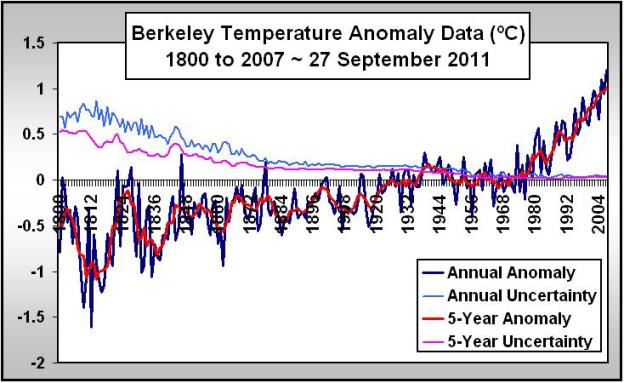
Data Source: Berkeley Earth Surface Temperature Study, 27 September 2011
In the vertical scale, 0ºC corresponds to the 1950-1980 mean land surface temperature
Results are based on 37633 time series with 14502771 data points
|
The Berkeley results confirm previous studies by NASA, NOAA, and the Hadley Climate Research Unit at the University of East Anglia, as shown by comparative plotting of the four sets of data:
|
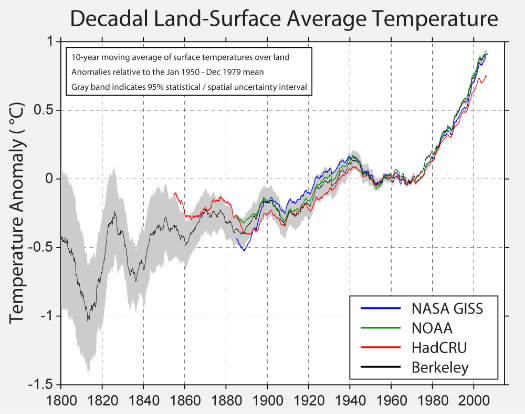
Source: Berkeley Earth Surface Temperature Analysis, 20 October 2011
10-year moving average of surface temperatures over land
Anomalies relative to the January 1950 - December 1979 mean
Gray band indicates 95% statistical / spatial uncertainty interval
REPRINTED WITH PERMISSION
Excerpt from A New Assessment of Global Warming: "The most important indicator of global warming, by far, is the land and sea surface temperature record. This has been criticized in several ways, including the choice of stations and the methods for correcting systematic errors. The Berkeley Earth Surface Temperature study sets out to to do a new analysis of the surface temperature record in a rigorous manner that addresses this criticism. We are using over 39,000 unique stations, which is more than five times the 7,280 stations found in the Global Historical Climatology Network Monthly data set (GHCN-M) that has served as the focus of many climate studies. Our aim is to resolve current criticism of the former temperature analyses, and to prepare an open record that will allow rapid response to further criticism or suggestions. Our results include not only our best estimate for the global temperature change, but estimates of the uncertainties in the record."
|
For a review of the Berkley study, see the 22 October 2011 issue of The Economist, which includes the following cartoon on global warming by David Simonds:
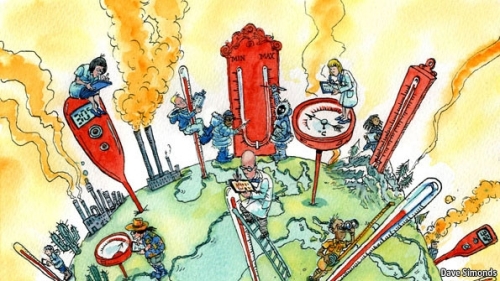
Published by The Economist, 22 October 2011
REPRINTED WITH PERMISSION
Another review:
New study shows Climategate scientists were right
By Bob McDonald, CBC News, 21 October 2011
Courtesy Quirks & Quarks, Copyright CBC Radio
Another independent study, this time from the United States, has shown that the climate scientists accused of the so-called "Climategate" affair were, in fact, right about the warming of the Earth.
The Berkeley Earth study was an independent scientific group, including this year's Nobel Physics Prize winner Saul Perlmutter, that used different and more detailed methods to analyze past climate records. But they came to the same conclusion that scientists at the University of East Anglia in England, as well as those at NOAA and NASA, have reached: that the climate over land has been on the rise since at least 1800, the beginning of the Industrial Revolution.
The intent of the study was to quell the voices of climate skeptics, who have charged that scientific methods were flawed and data have been manipulated or skewed to support climate warming. One of the biggest criticisms of past studies is that many weather recording stations are in urban areas, where heat from cities would give false readings. This study, using data from about 40,000 weather stations around the world, showed that while cities do indeed create a heat island effect, they do not affect the overall climate of the planet, because cities only cover about one percent of the land.
The report also showed how cooling periods, which are also used by skeptics to show warming is not happening, are caused by oscillating ocean currents, which can lower average temperatures for years; but then the trend continues its long-term upward climb. It's all part of the process of a changing climate. The scientists in the study have also made all their data and methods available for scrutiny online, to show total transparency.
This is sweet news for scientists at the Climate Research Unit at East Anglia, who had emails hacked and were falsely accused of manipulating data. More importantly, the report will provide ammunition for politicians preparing for the next UN Climate Summit in South Africa next month.
At the same time, a large consortium of more than 200 corporations from around the world, called the 2°C Challenge, is calling for government action on climate change. The business community realizes that there are considerable costs involved if nothing is done to curb climate change, and profits to be made if companies "go green."
In recent years, these annual UN summits have been deadlocked by countries, including Canada, that often claim the climate science is uncertain, and that the cost of change would hurt the economy. This study and the growing consensus of the corporate community (outside the fossil fuel industry) show that those statements are no longer valid excuses for inaction.
The scientists have done their work and stand united on their results. The business community agrees. Now it's time for the politicians to get on with doing something about it.
|
Another recent report:
Global Temperatures in September Were Eighth Warmest on Record
National Oceanic and Atmospheric Administration, October 13, 2011
Excerpt: "The Earth experienced its eighth warmest September since record keeping began in 1880. The combined global land and ocean average surface temperature was 59.95ºF, which is 0.95ºF above the 20th century average of 59.0ºF. Separately, the global land surface temperature was 1.57ºF above the 20th century average of 53.6ºF, making this the fourth warmest September on record. The September global ocean surface temperature was 0.72ºF above the 20th century average of 61.1ºF, making it the 14th warmest September on record. The annual minimum Arctic sea ice extent was reached on September 9 and ranked as the second smallest extent since satellite records began in 1979."
|
Another assessment of the current situation:
Our sustainable Earth
Raymond L. Orbach, Professor and Director, Energy Institute, University of Texas at Austin
IOP Science, October 2011
Abstract: "Recent evidence demonstrates that the Earth has been warming monotonically since 1980.
Transient to equilibrium temperature changes take centuries to develop, as oceans are slow to
respond to atmospheric temperature changes. Atmospheric CO2 concentrations, from ice core
and observatory measurements, display consistent increases from historical averages,
beginning in about 1880, and can be associated with the industrial revolution. The climactic
consequences of this human dominated increase in atmospheric CO2 define a geologic epoch
that has been termed the ‘Anthropocene.’ The issue is whether this is a short term, relatively
minor change in global climate, or an extreme deviation that lasts for thousands of years. Eight
‘myths’ that posit the former are examined in light of known data. The analysis strongly
suggests the latter. In order to stabilize global temperatures, sharp reductions in CO2
emissions are required: an 80% reduction beginning in 2050. Two examples of economically
sustainable CO2 emission reduction demonstrate that technological innovation has the
potential to maintain our standard of living while stabilizing global temperatures."
|
Another assessment of the current outlook:
Warming Could Exceed Safe Levels in This Lifetime
Nina Chestney, Reuters, 24 October 2011
"Global temperature rise could exceed "safe" levels of two degrees Celsius in some parts of the world in many of our lifetimes if greenhouse gas emissions continue to increase, warned two research papers published by academics at the English universities of Reading and Oxford, the UK's Met Office Hadley Center and the Victoria University of Wellington, New Zealand in the journal "Nature." Large parts of Eurasia, North Africa and Canada could potentially experience individual five-year average temperatures that exceed the 2 degree Celsius threshold by 2030. The study found that most of the world's land surface is very likely to experience five-year average temperatures that exceed 2 degrees above pre-industrial levels by 2060. If emissions are substantially lowered, the two degree threshold might be delayed by up to several decades, it added. However, even if global temperature rises are kept under two degrees by aggressive emissions cuts, some regions will still not avoid warming and the likelihood of extreme events such as heatwaves is still high in even a marginally warmer world."
|
Given the realities of human nature and financial vested interests, climate skeptics may choose to remain skeptical. Much work remains to be done, scientifically and politically. Scientific research is always about probabilities, and it has already been pointed out that the next critical step going forward is to rework the "Berkeley Study" specifically for ocean surface temperatures. The study results and supporting technical papers (currently undergoing peer review) are available from the Berkeley Earth website:
It is no longer reasonable to doubt that clean energy is indispensable to contain global warming. However, in order to attain joint integrity of human activity and the human habitat, a radical cultural change will be required. An extensive transdisciplinary review of the literature on human ecology, and the ecological impact of human activity, has been done and documented. Click here to review this material. The bottom line is that net planetary energy balance, in conjunction with a culture of human solidarity contingent on gender balance in all roles of responsibility and authority, are essential for ensuring a civilized transition from fossil fuels to clean energy, a civilized transition from consumerism to sustainability, and further sustainable advances in integral human development.
EDITOR'S NOTE: A synthesis of this material as it pertains to the energy-economic-ecological crisis is taking shape and is reported in Section 7 of this page.
|
3. Mitigation Strategies for Sustainable Human Development
|
There are two broad sets of strategies to ensure the long-term sustainability of the human habitat: mitigation and adaptation. As currently formulated in a globally patriarchal context, neither one assures a civilized transition from consumerism to sustainability. Such a transition becomes feasible if, and only if, there is a confluence of energy balance and gender balance. Energy balance, and a shift from fossil fuels to clean energy, is indispensable. The other indispensable catalyst is the transition from patriarchal domination to cross-gender solidarity.
Mitigation Strategies
In general, mitigation strategies attempt to minimize the risks associated with an impending threat. Ecologically, mitigation strategies attempt to reduce the rate of natural resource depletion and other negative impacts of economic activity on the human habitat. There are many kinds of mitigation strategies depending on culture, geography, the nature of the threat, vulnerability to a given threat, and the human/habitat resources to be protected from a given threat. There is significant overlap.
The following are examples of mitigation strategies:
- Economic and Technological Transition from Fossil Fuels to Energy Balance
-
Greenhouse Gas Mitigation Strategies
- Energy Conservation and Efficiency
- Appropriate Heating and Power Plant Fuel Choices
- On-Site Renewable Energy Technologies
- Buy Green Power
- Maximize Space Utilization to Minimize or Avoid New Construction
- Design and Construct Only the Greenest, Most Energy Efficient New Buildings
- Sustainable Transportation Solutions
- Other GHG Mitigation Strategies (waste disposal, purchasing, food)
- Carbon Offsets to Address Remaining Emissions
- Climate Change Mitigation Strategies
- Shift to low carbon fuels
- Efficiency programs on energy supply and use
- Reduction of leaks from gas plants
- Controlling transport related emissions
- Reduction of emissions by change in agricultural systems
- Maintaining and expanding sinks by protecting forest and practicing agro-forestry and other plantation exercises
- Changing cattle feed to reduce methane emitted and utilizing methane produced
- Giving highest priority to options that reduce more than one type of GHG
- Ecosystem Change Mitigation Strategies
- Sustainability of biomes and ecological systems (ecosystems)
- Aquatic (oceans, freshwater)
- Land (tundra, desert, alpine, grasslands, tropical forests, decidious forests, ...)
- Sustainability of ecosystem services
- Provisioning services (food, fresh water, wood, fuel, ...)
- Regulating services (climate, flood, disease, water purification, ...)
- Cultural services (aesthetic, educational, recreational, spiritual, ...)
- Sustainability of human well-being
- Basic material resources (nutrients, minerals, shelter, ...)
- Security of persons and communities (safety, access to resources, disaster recovery, ...)
- Health (clean air, clean water, clean food, ...)
- Social relations (social cohesion, space, solidarity, ...)
- Integral human development (basic needs, education, jobs, vocations, ...)
- Climate Engineering: Technical Status, Future Directions, and Potential Responses
- Carbon Capture and Utilization in the Green Economy
- Financing of Energy Efficiency
- Financing the Transition to the Low-Carbon Economy
- Mitigating Climate Change Through Food and Land Use
- Low-Carbon Energy: A Roadmap
- Manufacturing Strategies for sustainability
- Geothermal Risk Mitigation Strategies
- Geologic CO2 Sequestration
- Cultural and Social Transition from Patriarchal Domination to Gender Balance
The goal is not to exceed sustainable material and energy flows. The effectiveness of mitigation strategies should be evaluated against this absolute goal. Clearly, if resource productivities increase (or resource intensities decrease) but total resource consumption rates increase even more due to population growth, economic growth, or any other reason, mitigation alone will not do. It is doubtful that mitigation strategies will obviate the need for a transition from fossil fuels to clean energy even if they are reinforced by a cultural transition from patriarchy to solidarity.
|
4. Adaptation Strategies for Sustainable Human Development
|
As already mentioned in the previous section, there are two broad sets of strategies to ensure the long-term sustainability of the human habitat: mitigation and adaptation. Most probably, attaining global energy balance will require significant adaptation of human behavior in conjunction with radical economic reforms. Such behavioral adaptation and structural reforms are contingent on gender balance and integral human development. As currently formulated in a patriarchal context, neither one assures a civilized transition from consumerism to sustainability. Such a transition becomes feasible if, and only if, there is a confluence of energy balance and gender balance. Energy balance, and a shift from fossil fuels to clean energy, is indispensable. The other indispensable catalyst is the transition from patriarchal domination to cross-gender solidarity.
Adaptation Strategies
Adaptation strategies attempt to reverse environmental degradation by changing patterns of human behavior regarding production and consumption of goods and services.
The following are examples of adaptation strategies:
Both mitigation and adaptation strategies have a role to play in attaining the transition to sustainability. But assuring the effectiveness of mitigation and adaptation strategies will require a radical upgrade in the quality of human relations, and this in turn will require a cultural transition from patriarchy to solidarity. This cultural transition has already started, but it may take a long time to run its course as it entails overcoming 5000+ years old bad mental habits. The transition from fossil fuels to clean energy may take a few decades but it is a matter of overcoming habits that are only 300 years old. Hopefully, increasingly pressing ecological issues and constraints will trigger human awareness and motivation to the point of enabling both transitions to unfold simultaneously and before it is too late.
|
5. Solidarity, Subsidiarity, Sustainability, and Nonviolence
|
Transitioning from consumerism to sustainability will require shifting gears in many significant ways. The following principles will be instrumental in attaining the transition to clean energy.
Key Principles
|
Principle of Solidarity
"Solidarity is the integration, and degree and type of integration, shown by a society or group with people and their neighbours. It refers to the ties in a society - social relations - that bind people to one another. The term is generally employed in sociology and the other social sciences."
Principle of Subsidiarity
"Subsidiarity is an organizing principle that matters ought to be handled by the smallest, lowest or least centralized competent authority... A central authority should have a subsidiary function, performing only those tasks which cannot be performed effectively at a more immediate or local level... Subsidiarity is, ideally or in principle, one of the features of federalism, where it asserts the rights of the parts over the whole."
Principle of Sustainability
"Sustainability is the capacity to endure. In ecology, the word describes how biological systems remain diverse and productive over time. Long-lived and healthy wetlands and forests are examples of sustainable biological systems. For humans, sustainability is the potential for long-term maintenance of well being, which has environmental, economic, and social dimensions."
Principle of Nonviolence
Dr. Martin Luther King Jr proposed the following as essential for practicing nonviolence:
- Nonviolence is a way of life for courageous people. It is a positive force confronting the forces of injustice, and utilizes the righteous indignation and the spiritual, emotional and intellectual capabilities of people as the vital force for change and reconciliation.
- The Beloved Community is the framework for the future. The nonviolent concept is an overall effort to achieve a reconciled world by raising the level of relationships among people to a height where justice prevails and persons attain their full human potential.
- Attack forces of evil, not persons doing evil. The nonviolent approach helps one analyze the fundamental conditions, policies and practices of the conflict rather than reacting to one's opponents or their personalities.
- Accept suffering without retaliation for the sake of the cause to achieve the goal. Self-chosen suffering is redemptive and helps the movement grow in a spiritual as well as a humanitarian dimension. The moral authority of voluntary suffering for a goal communicates the concern to one's own friends and community as well as to the opponent.
- Avoid internal violence of the spirit as well as external physical violence. The nonviolent attitude permeates all aspects of the campaign. It provides mirror type reflection of the reality of the condition to one's opponent and the community at large. Specific activities must be designed to help maintain a high level of spirit and morale during a nonviolent campaign.
- The universe is on the side of justice. Truth is universal and human society and each human being is oriented to the just sense of order of the universe. The fundamental values in all of the world's great religions include the concept that the moral arc of the universe bends toward justice. For the nonviolent practitioner, nonviolence introduces a new moral context in which nonviolence is both the means and the end.
|
A shift is needed from the (currently dominant) use of non-renewable energy resources to quasi-exclusive use of renewable energy resources. Technologies to develop and deliver clean energy are readily available. But existing technologies, and improved ones to be developed, can make a positive contribution if, and only if, the human side of the equation (as outlined in the preceding sections) is taken care of.
|
6. Non-Renewable & Renewable Energy Resources
|
Continued use and abuse of non-renewable energy sources is unsustainable. In the long-term, renewable energy sources will be indispensable. Technologies are available (or can become available with appropriate incentives) that would make it possible to meet most human energy needs with clean energy by 2050. However, to make it happen is mainly a social issue, not a technical one. Consider the following data and projections from the International Energy Outlook (IEO) 2011, Energy Information Administration, US Department of Energy, September 2011:
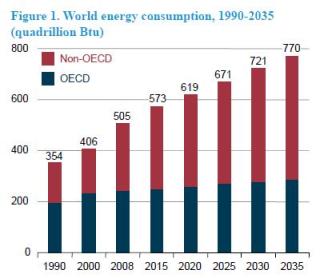
Source: IEO 2011 Figure 1, US DOE/EIA, 2011
|
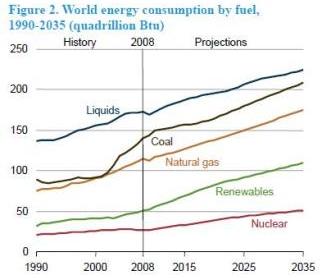
Source: IEO 2011 Figure 2, US DOE/EIA, 2011
|
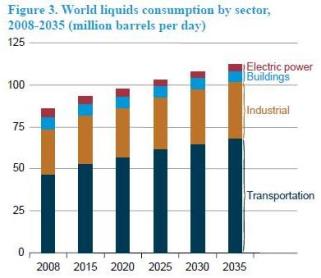
Source: IEO 2011 Figure 3, US DOE/EIA, 2011
|
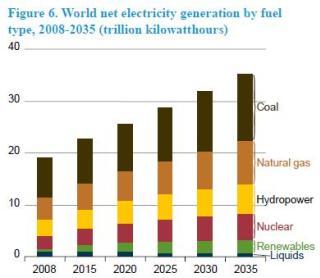
Source: IEO 2011 Figure 6, US DOE/EIA, 2011
|
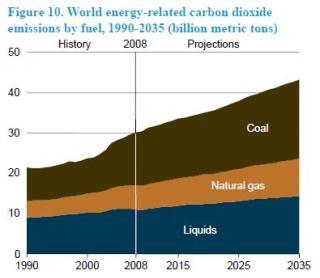
Source: IEO 2011 Figure 10, US DOE/EIA, 2011
|
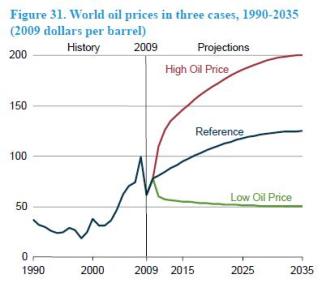
Source: IEO 2011 Figure 31, US DOE/EIA, 2011
|
The projections to 2035 in Figures 1 and 2 suggest that, while energy demand will continue to grow, no significant shift from fossil fuels to renewables is to be expected. Figures 3 and 6 partition the projections to show the same thing by human activity (note the huge energy demand for transportation!) for the generation of electricity (note the persistent trend for coal burning!). Figure 10 shows the anticipated CO2 emissions by fuel, and Figure 31 shows the expectation that oil prices will continue to rise but not too much (reference case). Since the demand for fossil fuels is very inelastic (what other choice do people have as long as there are no clean energy alternatives?) this composite set of projections does not bode well for either the future health of the planet or the wellbeing of humanity; for humans are bound to be affected by continued environmental deterioration and climate change. Thus is the nature of an economic system in which short-term profits are the sole arbiter of production and consumption decisions.
Lurking under these rosy projections of global energy production and consumption (and many other similar projections by other notable think tanks worldwide) is the implicit assumption that economic growth - in terms of production and consumption of material commodities - will continue to grow even if population stabilizes. Any other assumption would be "politically incorrect" and therefore ruled out. However, the energy return on energy investment (EROEI, or EROI), and therefore the financial return on investment, is much higher for non-renewables than for renewables, as shown in the chart inserted to the right. As long as this is the case, the worldwide carbon-based economic and financial systems - driven as they are to minimize "time to market" and maximize short-term profits "one quarter at a time" - are utterly unable to shift priorities from carbon-based growth to sustainable stability. As economist Milton Friedman has pointed out, "only a crisis - actual or perceived - produces real change. When the crisis occurs, the actions that are taken depend upon the ideas that are lying around. That, I believe, is our basic function: to develop alternatives to existing policies, to keep them alive and available until the politically impossible becomes politically inevitable." A compilation of such alternatives, by no means exhaustive or definitively integrated, is presented in Section 7.
Assessment and Data on Non-renewable Energy Sources
- GENERAL
- COAL
- OIL
- GAS
- NUCLEAR
Assessments and Data on Renewable Energy Sources
- GENERAL
- SOLAR
- WIND
- HYDROPOWER
- GEOTHERMAL
- BIOMASS & BIOFUELS
- WAVE & TIDAL
Human willingness and technical innovation can make it possible to integrate the behavioral and technical sides of the transition puzzle. However, technological innovation alone is not likely to be sufficient. Strong economic incentivation, and significant human adaptation, will probably be required.
|
7. Integrated Strategy for the Transition to Clean Energy
This section presents the emerging synthesis of all the information in sections 1 to 7. The synthesis is presented in the form of a concept that integrates the social, economic, and energy issues that must be resolved to attain a civilized (i.e., humane) transition during the first half of the 21st century. Energy balance for entropy control is a non-negotiable requirement, and gender balance for violence mitigation is an indispensable catalyst for the transition.
There is a propensity to violence in patriarchal cultures that is a natural consequence of male human biology and the macho propensity to domination and control. Since violence is the greatest obstacle to human development, let alone sustainable human development, it follows that patriarchal cultures must be reformed if we are to attain sustainability. The patriarchal behavior of domination and control also leads to psychological stress, which reinforces the propensity to use violent means to pursue human goals as well as the propensity to attempt reaching such goals sooner rather than later. Thus short-term goals are pursued with minimal or no consideration for long-term priorities such as safaguarding the wellbeing of future generations.
Thus it is that the transition from patriarchy to gender balance is a prerequisite for the transition from consumerism to sustainability. Furthermore, the reformation of patriachy is not just a matter of pursuing superficial improvement in terms of gender equity (e.g., closing the pay gap), gender equality (fully sharing human nature and human dignity), and gender balance (fully sharing responsibilities and roles of authority). Full gender equality, and authentic gender balance, will require transcending deeply ingrained masculinist prejudices that scholarly research in human sexuality and gender construction is barely starting to expose. This is not to imply that "perfect" gender balance must be achieved before the transition to sustainability starts. On the contrary, the hypothesis proposed below is that the process toward gender balance in human affairs, and the process toward energy balance and ecological sustainability, will reinforce each other in many significant ways.
The transition concept is presented next from the process dynamics and time-phasing perspectives:
|
INTEGRATED TRANSITION STRATEGY - PROCESS DYNAMICS VIEW
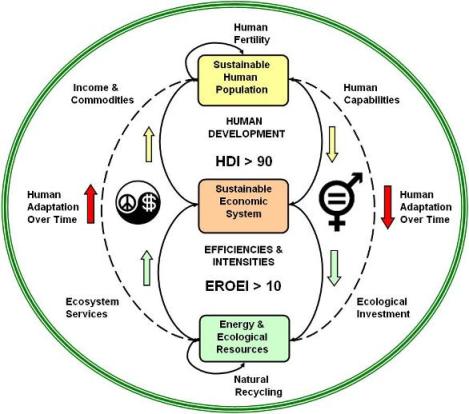
Bounded Population-Economic-Ecological System for Sustainable Human Development
Adapted from
Prosperity without Growth, Tim Jackson, 2011, Figure 12.1, Page 195
BASIC ARCHITECTURE FOR SDSIM 2.0
There are three sets of feedback loops: human development, human adaptation, and industrial mitigation.
- Human Development Loops (yellow arrows)
The human development loops improve gender equality and other human capabilities, and guide the allocation of income/commodities generated by the economic system. Gender equality is the most crucial factor to reinforce the human development loops. Gender balance for responsible human reproduction and economic policy-making is indispensable to transition from a profit-driven economy with technological innovation at the service of financial capital accumulation to an economy where meeting human development needs is the top priority.
- Human Adaptation Loops (red arrows)
The human adaptation loops drive ecological investment so as to enhance the sustainability of ecosystem services. Gender equality is the most crucial factor to reinforce the human adaptation loops. Gender balance in environmental protection and the management of ecosystem services is essential to transition from an economy that attempts to dominate nature to an economy that strives for survivability by investing in ecological capital to ensure symbiotic balance between humanity and the human habitat. It cannot be overemphasized that these adaptation loops will remain dormant as long as the patriarchal (masculinist) mindset governs economic decisions and seeks short-term expedience and short-term profits without regard for the long-term common good.
- Industrial Mitigation Loops (green arrows)
The industrial mitigation loops improve the productivity of energy and other resources by using "industrial engineering" methods. These loops strive to minimize the energy/resource intensity of goods and services and minimize GHG emissions and other forms of waste - toxic waste in particular. Methods of industrial engineeering and operations research (under various names encompassing the full spectrum of science and engineering) are to be applied within the framework of a total population-economy-environment system. Mitigation loops are helpful as long as their operation is subservient to, and do not interfere with, the human development and human adaptation loops.
PROCESS DYNAMICS
The convergence of gender balance, energy balance, and sustainability emerges from gender imbalance and energy imbalance jointly driving human civilization toward unsustainability. Many other factors are involved, but gender and energy imbalances are the most pervasive, and balancing them would have a neutralizing effect on all the other factors that conspire against a sustainable human society. If the transition from consumerism to sustainability is to be attained in a timely and civilized manner, i.e., before it is too late and minimizing violence as much as possible, balancing gender relations and energy flows would be the best (perhaps the only?) way to go.
Balancing gender relations is more than just gender equity, even though attaining gender equity is a good start. It also goes beyond gender equality as a merely theoretical recognition of human dignity regardless of gender, but one that fails to exorcise patriarchal modes of thinking and behaving. Gender balancing for sustainability would require wide open access to all roles of authority and responsibility without any artificial gender-based limitation. Sanitizing hearts and minds from patriarchy is needed in all dimensions of human life, both secular and religious. Then, and only then, can human behavior - and policy decisions - exhibit the mix of masculine and feminine traits that will be required to reconcile humanity with the human habitat.
With regard to balancing energy flows, it is a matter of facing two realities and acting accordingly. One reality is that balancing energy flows through the global system is an unavoidable requirement of the physical laws of thermodynamics. There is no way around that. Another reality is that extracting energy from carbon-intensive fossil fuels always entails a net energy flow imbalance (i.e., energy input > energy output). Therefore, using fossil fuels as a source of energy must give way to using clean (renewable) energy sources, and the sooner the better. Since energy is needed for all human activities, the transition to clean energy is bound to mitigate carbon-induced climate change and drive adaptation in all industrial sectors of the global economy.
It must be noted that "gender balance" entails more than just "gender equity" (equal pay) and more than "gender equality" (equal dignity); it requires exorcising patriarchal modes of thinking and behaving, and open access to all roles of responsibility and commensurate authority -- regardless of artificial gender-based exclusions -- in order to have a healthy mix of masculine aggressiveness and feminine nurturing in human behavior and policy formulation. It is the confluence of gender balancing and energy balancing, acting together with rippling effects throughout the global human system, that can become a catalyst for a relatively benign transition from consumerism to sustainability. Else, the inevitable transition will come to pass but probably at the price of much violence and human suffering.
INTEGRATED TRANSITION STRATEGY - PHASES VIEW
There are four phases: concientization, incentivation, redistribution, and democratization. Phases may overlap recursively. Time is of the esence, but the time windows are impossible to predict.
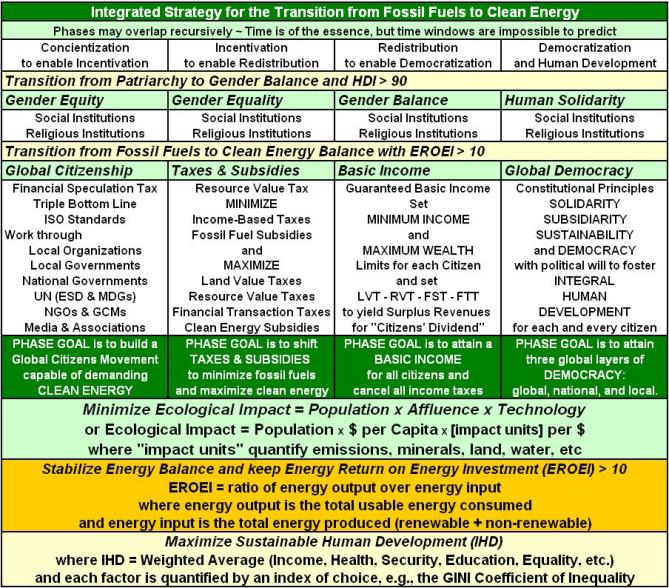
The following acronyms, and terminology are used in this transition concept and subsequent discussion:
Energy Return on Investment (EROI)
Energy return on Energy Investment (EROEI)
Financial Transaction Tax (FTT)
Global Citizens Movement (GCM)
Human Development (HD)
Human Development Index (HDI)
Human Development Report (HDR)
Integral Human Development (IHD)
International Standards Organization (ISO)
|
Land Value Tax (LVT) or Resource Value Tax (RVT)
Maslow's Hierarchy of Human Needs (MASLOW)
Non-Governmental Organization (NGO)
Principle of Solidarity (SOLIDARITY)
Principle of Subsidiarity (SUBSIDIARITY)
Principle of Sustainability (SUSTAINABILITY)
Sustainable Development (SD)
Sustainable Human Development (SHD)
Triple Bottom Line (TBL)
|
The formula I=PxAxT, known as "Ehrlich's Equation," is generally recognized as a good model for the ecological impact of economic activity. The impact is a nonlinear function of human population (P, # of persons), affluence (A) measured as consumption per capita ($/person), and a technology factor (T) that quantifies the impact (in physical units) per dollar of consumption. Note that for impact (I) to decrease, the technology factor (T) must go down faster than the product of population (P) and lifestyle (A) grows.
|
Several formulations are possible for IHD. The best known is the United Nations' Human Development Index (HDI) which includes three components: life expectancy, years of schooling, and GNP per capita. The are many variations of the HDI to include, for example, the gender equality dimension. Other indices attempt to replace GNP with other measures of human wellbeing, such as the Genuine Progress Indicator (GPI), the GINI Cofficient of Inequality, and the Happy Planet Index (HPI).
|
|
The transition entails maximizing human development and wellbeing as much as possible, and minimizing ecological impacts as much as possible, in a manner that leads to economic and ecological stability. Clearly, maximizing human wellbeing and minimizing ecological impact are mutually contradictory goals as long as human wellbeing is measured in terms of material consumption per capita. Since there are resource limits, and there are limits to efficiency improvements via technological innovation, something must give: humans must adapt by shifting expectations of wellbeing from economic affluence to other human development goals. It is impossible to predict how this adaptation process will unfold, but the following synopsis of the transition phases is proposed as a point of reference:
- The first phase is concientization to enable incentivation
The objective is to create widespread popular support for the required revisions of tax codes and energy subsidies. In other words, the first phase is about creating a collective mindset of global citizenship and social responsibility, strong enough to translate into political will to face the inevitable transition and implement required reforms. Gender equity is key.
- The second phase is incentivation to enable redistribution
The objective is to reform tax codes and energy subsidies to expedite the transition from fossil fuels to clean energy. Applicable reforms include shifting taxes from earned income to the usage (extraction) of unearned resources and the release of pollution, as well as taxing financial transactions of dubious social value. Gender equality is key.
- The third phase is redistribution to enable democratization
The objective is to institutionalize democracy with gender balance and distributive justice. This may entail adopting a Universally Guaranteed Personal Income (i.e., a basic minimum income rather than a minimum wage) and a Maximum Allowable Personal Wealth (i.e., an upper limit on financial wealth accumulation) that can be democratically adjusted periodically.
- The fourth phase is worldwide democratization
The objective is democratization of global, national, and local governance with deeply ingrained gender balance and widely institutionalized implementation of the solidarity, subsidiarity, and sustainability principles. Decisions are to be made at the lowest possible level consistent with governance capabilities and the common good of humanity.
SOME KEY POINTS ON TIME-PHASING:
- The four phases are not envisioned to be strictly sequential. They most probably will overlap, with recursions and convulsions along the way.
- The term "gender equality" is not to be understood as "gender uniformity." By gender equality is meant equality of dignity and personal development opportunities across the entire gender continuum. In other words, full equality in all dimensions of human life: physical, intellectual, psychological, vocational, spiritual.
- A menu of possible actions to foster gender equality is still TBD, but fostering gender equality (100% participation) will be crucial in all four phases and beyond. It is anticipated that action items pursuant to overcoming patriarchy would include:
- National movements such as the Equal Rights Ammendment in the USA.
- Regional programs such as the European Institute for Gender Equality.
- International programs such as the UN MDGs, ESD, CEDAW, and UNWOMEN.
- Support initiatives in secular institutions (pay gap, gender quotas, etc).
- Support initiatives in religious institutions (women in roles of religious authority).
- Research on issues of human sexuality and gender equality.
- Research on patriarchy, linguistics, human languages, and gender equality.
- The term "clean energy" is to be understood as "clean renewable energy" that is naturally replenished and does not produce GHG emissions when used. It does not include absurdities such as "clean coal."
- The menu of possible actions offered to foster clean energy is not presumed to be complete or definitive. Various mixes of monetary and fiscal policies are possible top down, and an incalculable number of bottom up initiatives are bound to emerge. However, the following fiscal and monetary policies are strongly recommended:
- Definition and implementation of appropriate financial speculation taxes as soon as possible (catastrophe prevention).
- Bailouts of any kind of institution via money supply mechanisms are to be made illegal as soon as possible (catastrophe prevention).
- A radical shift of tax burdens from the middle class to the very rich (distributive justice).
- A radical shift from taxing income to taxing resource usage and unabated pollution (ecological justice).
- A radical shift from social welfare programs to basic income and help-yourself programs (distributive justice).
- A gradual shift from "international development assistance" to global equity practices (restorative justice).
- A gradual evolution toward the minimal required form of environmental/resource global governance (sustainability assurance).
- It is understood that other factors or combinations of factors may be necessary and/or sufficient for the transition:
- Education on nonviolence, solidarity, subsidiarity, sustainability, and other best practices to foster a civilized transition.
- Zero tolerance of war, genocide, and other forms of institutionalized violence at any level of governance.
- Protection of human rights and sustainable human development to become top priorities at all levels of governance.
- Technology and industrial production are to be at the service of human development, not the other way around.
- Inter-industry collaboration pursuant to maximum pollution mitigation during the transition.
- Inter-industry adaptation of products and technologies in transitioning from fossil fuels to clean energy.
- Consumption mitigation and adaptation to pollution-free and climate-friendly goods and services.
- However, the combination of gender balance and energy balance is hereby proposed as the necessary and sufficient driver for a civilized (i.e., humane) transition, and are expected to have a multiplying effect throughout the global human system.
The following synthesis is a "working hypothesis" that attempts to encapsulate our current understanding of the issues and suggests an agenda for researchers and activists:
|
WORKING HYPOTHESIS
Human willingness and technical innovation can make it possible to integrate the behavioral and technical sides of the transition from consumerism to sustainability. However, it is reasonable to anticipate that technological innovation alone will not be sufficient. Strong economic incentives, and significant human adaptation, will be required. By "significant" is meant a radical departure from extreme capitalist and socialist mindsets, both of which are rooted in a patriarchal culture hardened by the masculinist propensity to violence traceable to primitive religious violence.
This urge to attain control and domination - of people and of nature - is deeply ingrained in human culture, with roots traceable to human evolution, human biology, and human psychology. It induces stress on individuals and communities to the point of seeking aggressive (and often even violent) short-term "solutions" to real or imaginary threats with almost complete disregard for the long-term wellbeing of humanity and the human habitat. Furthermore, the energy return on energy investment, and therefore the financial return on capital investment, is much higher for non-renewables than for renewables. As long as this is the case, the worldwide carbon-based economic and financial systems - conditioned as they are to minimize "time to market" and maximize short-term profits "one quarter at a time" - are utterly unable to shift priorities from unsustainable growth to sustainable stability.
Men are not the problem.
Women are not the problem.
Business is not the problem.
Government is not the problem.
Patriarchy is the problem.
|

|
Indeed, patriarchy is the problem. Patriarchal civilizations beget dysfunctional societies - and communities, and families - because their concept of civility is corrupted by power. Violence goes around, and comes around, in many different forms and flavors; sometimes presumptiously disguised as "the hand of God," very often viewed by both victims and victimizers as the "natural order of things." Needless to say, victimizers eventually become victims, and the vicious cycle continues ... ad nauseam.
A testosterone-driven culture is bound to be a violent culture, and experience confirms that this applies to both the secular and religious dimensions of human affairs. As long as patriarchy remains normative, a civilized (i.e., humane, sensible) transition from consumerism to sustainability is humanly impossible; for such a transition would entail a radical renunciation of violence that will remain
biologically and psychologically impossible as long as patriarchy is not superseded by gender balance in all social (and religious) roles of responsibility and authority.
Then, and only then, can a sensible transition unfold by overcoming the masculinist culture of violence and pave the way for individuals and nations to take into account both legitimate self-interest and the common good; transferring tax burdens from earned income to financial speculation (e.g., derivatives trading), resource depletion (at the point of extraction), and environmental degradation ("polluter pays" principle); declaring some form of debt jubilee and/or creating debt-free money by central and regional banks; seeking distributive justice via a democratically set universal guaranteed personal income; balancing globalization with financial localization via local currencies and/or exchange trading systems; adopting business practices such as the triple bottom line (people, planet, profit); working out the economic and technological issues that must be resolved in order to migrate from fossil fuels to clean energy; consolidating democracy at all levels by firm adherence to the wise principles of solidarity, subsidiarity, and sustainability; and giving top priority to sustainable human development rather than unsustainable resource exploitation and wealth accumulation.
This is not to imply that a complete exorcism of masculinist demons, and perfect gender balance, must be achieved before the transition to sustainability can start. On the contrary, the hypothesis is that the process toward sustainability has already started, even though it remains invisible for many. But attaining gender balance in human affairs, and the process toward energy balance and ecological sustainability, will reinforce each other in many significant and mutually beneficial ways. Pursuing gender balance is the catalyst that will brake the current impasse and get the process going. Since the "patriarchs" will seldom (if ever!) pour the catalyst down from the top, it must gently percolate upwards from the grassroots: individual citizens, families, groups, and local communities.
|
This synthesis attempts to integrate several dimensions of knowledge and experience, including science and engineering, technology management, ecology, economics, finance, psychology, human sexuality and gender, religion, philosophy, and ethics. For a detailed list of supporting references click here.
Nothing is totally unrelated to sustainable human development. An invaluable online resource for transdisciplinary research is The Ten Pillars of Knowledge by Chaim Zis (Knowledge Mapping Research, Jerusalem, Israel). There can be many variations of any conceivable transition scenario. Some of the variations to be investigated are identified in the following section.
|
8. Variations of the Integrated Transition Strategy
|
In terms of the transition from fossil fuels to clean energy, there seems to be a convergence of outlook that is shared by business, agencies, and NGOs. For example, the following table juxtaposes the latest global transition projections by British Petroleum (BP), the Energy Information Administration (EIA), the World Wildlife Fund (WWF), and Paul Chefurka's World Energy and Population (WEAP) website. The time windows are not the same, and the energy units are defined differently, but the patterns of energy substitution are comparable. The BP outlook is the most optimistic about sustaining the supply of fossil fuels and the most pessimistic about renewables meeting a significant share of energy needs. The EIA outlook is very similar. However, in terms off replacing fossil fuels with clean energy is a post-carbon world, he WWF outlook is the most optimistic and the WEAP outlook the most pessimistic. This is due to optimistic versus pessimistic assumptions about the timing of supply peaks for non-renewables and ramping up capacities for renewables.
Energy in Billion TOE
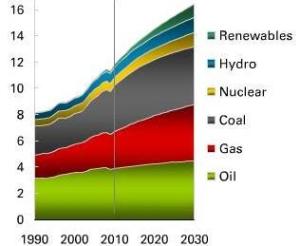
BP Outlook 1990-2030
For larger image, see BP Page 16
|
Energy in Quadrillion BTU
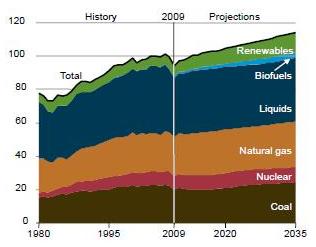
EIA Outlook 1980-2035
For larger image, see EIA Page 63
|
Energy in EJ/a
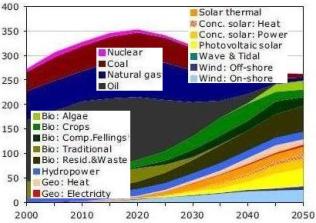
WWF Outlook 2000-2050
For larger image, see WWF Page 92
|
Energy in Million TOE
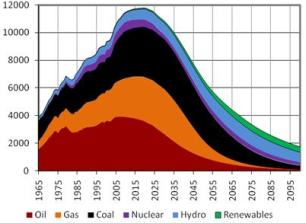
Paul Chefurka's WEAP outlook
For larger image, see WEAO Figure 13
|
For the current level of climate change mitigation technologies, it would seem that the BP and EIA scenarios are too optimistic in assuming that the production of fossil fuels can be sustained and the planet can absorb the resulting accumulation of GHG emissions without potentially catastrophic climate disruptions. The WWF scenario is more reasonable from a mitigation perspective, but may be too optimistic about the readiness of clean energy technologies and human responsiveness to adaptation strategies. The WEAP scenario may be too pessimistic, and hopefully will not come pass as the human-impact implications would be severe, but there is always the need to plan for the worst case scenario. With this range of scenarios in mind, the following variations are being considered for modeling and analysis:
- Variations in the timing and duration of human adaptations
- Variations in the human propensity to consume (volume, choices, fix vs replace
- Variations in the human propensity to adapt (climate, migration, transportation)
- Variations in the pace of progress in secular gender equity, equality, and balance
- Variations in the pace of progress in religious gender equity, equality, and balance
- Variations in the adaptability of the world financial system (speculation, regulation)
- Variations in the resilience of the human habitat (pollution, climate, ecosystem services)
- Variations in fossil fuel reserves and the timing of "peak oil"
- Variations in the timing and intensity of climate changes
- Variations in the performance, schedule, and cost of clean energy technologies
EDITOR'S NOTE: These variations are to be formulated and explored with SDSIM 2.0 (to view SDSIM 1.5, click here).
|
9. Strategic Data Sources & Global Transition Megatrends
|
Listed below are links to the best data and knowledge sources in two categories: strategic data sources and global transition megatrends.
KEY LINKS:
- STRATEGIC DATA SOURCES
- UNFCCC Technology Information System, UNFCCC Presentation, 2002.
- Great Transition Initiative (GTI) Scenarios and Database, GTI, 2007.
- Maps and Graphics Library, UNEP/Arindal, 2008.
- World Income Inequality Database, WIID, UNU-WIDER, 2008.
- Human Development Index (HDI) Database, UNDP, 2010.
- 2010 World Population Data Sheet, PRB, 2010.
- Policies and Measures Databases, UN International Energy Agency (IEA), 2011.
- Energy Research Guide and Database, US Energy Information Agency (EIA), 2011.
- Energy Outlook 2030, BP, 2011.
- Statistical Review of World Energy 2011, BP, 2011.
- 100% Renewable Energy by 2050, WWF, 2011.
- IMF Financial Databases, IMF, 2011.
- World Income Inequality Database (WIID)
- 2011 World Population Data Sheet, PRB, 2011.
- Gender, Institutions and Development Data Base (GID-DB), OECD, 2011.
- USA Federal Government Databases (DATA), US Government, 2011.
- United Nations Database (UNData), United Nations, 2011.
- International Energy Outlook 2011, US DOE/EIA, September 2011.
- Global Megatrends Factsheet, German Advisory Council on Global Change (WBGU), October 2011.
- GLOBAL TRANSITION MEGATRENDS
The precision and accuracy of the data sources listed above span the entire spectrum from "very soft" to "somewhat credible." The visible megatrends are highly aggregated and therefore less sensitive to data collection inadequacies. Still invisible is the most critical megatrend toward gender equality/gender balance in roles of responsibility and authority.
|
|
|Back to the SUMMARY|
|Back to SECTION 1|
|Back to SECTION 2|
|Back to SECTION 3|
|Back to SECTION 4|
|Back to SECTION 5|
|Back to SECTION 6|
|Back to SECTION 7|
|Back to SECTION 8|
|Back to SECTION 9|
Page 1
Page 2
Page 3
Page 4
Page 5
Page 6
Page 7
Page 8
Page 9
Supplement 1
Supplement 2
Supplement 3
Supplement 4
Supplement 5
Supplement 6
PelicanWeb Home Page
|
|
"The climate system is an angry beast,
and we are poking at it with sticks."
Wallace S. Broecker, c. 1991
|
|
Supplement 3
|
|
FREE SUBSCRIPTION
|
![[groups_small]](groups_small.gif)
|
Subscribe to the
Mother Pelican Journal
via the Solidarity-Sustainability Group
Enter your email address:
|
|
|
|